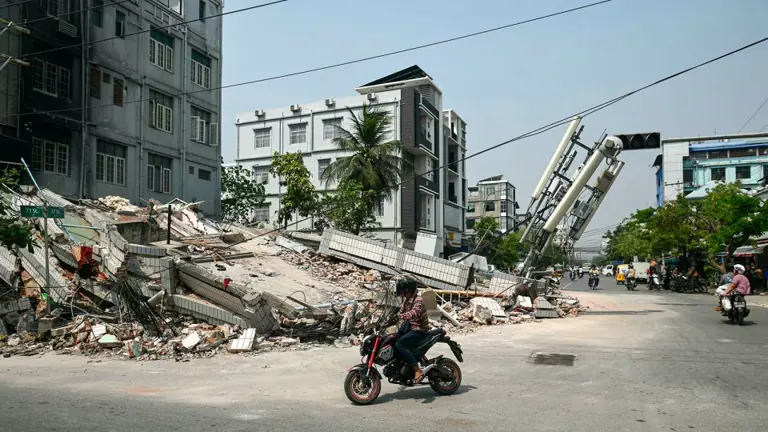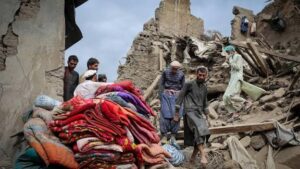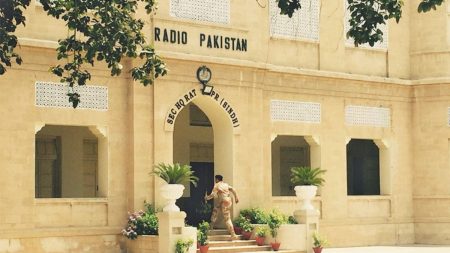Islamabad, April 02: The death toll from the devastating earthquake in Myanmar has climbed to 2,886, with 4,639 injured and 373 still missing, according to China’s state-run Xinhua, which cited Myanmar’s State Administration Council on Wednesday.
Buildings across Myanmar continue to collapse five days after the powerful 7.7-magnitude earthquake struck, creating life-threatening conditions for rescue workers as they search for survivors trapped under the rubble.
Growing Casualties and Ongoing Rescue Operations
Myanmar’s military junta has reported that more than 2,700 people have lost their lives, with thousands more suffering injuries. As hundreds remain unaccounted for, officials anticipate the death toll will rise further.
In a moment of rare hope, Myanmar’s Fire Services Department released a video of rescue workers in Naypyidaw pulling a man from the debris over 100 hours after the quake.
The exhausted survivor, found in an air pocket between collapsed concrete slabs, was greeted with applause upon his rescue.
A similar rescue was reported a day earlier when a 62-year-old woman was freed from the rubble in Naypyidaw.
Additionally, a team of Chinese rescuers saved four people on Monday, including a five-year-old child and a pregnant woman.
Despite these successes, structural vulnerabilities remain a major concern. Two hotels collapsed near the epicenter in Mandalay on Monday night after residents attempted to return to the buildings following the initial quake.
“With ongoing aftershocks, fatalities are still occurring,” said Michael Dunford, Myanmar director at the United Nations World Food Programme (WFP).
He noted that fear of further collapses has forced many people to sleep outdoors in parks and streets, making it difficult for aid workers to reach those in need.
Urgent Humanitarian Needs in Myanmar
Humanitarian organizations continue to emphasize the need for immediate aid, particularly in remote areas. Even before the earthquake, Myanmar’s four-year civil war had left millions without proper shelter, medical care, and communication infrastructure.
In Sagaing, near the earthquake’s epicenter, residents describe a desperate situation as they wait for medical supplies and food. According to Amnesty International, there is an urgent demand for body bags, torches, and mosquito repellents.
However, reports indicate that military authorities are imposing strict surveillance on vehicles transporting aid into Sagaing from Mandalay.
“Soldiers are closely inspecting deliveries, and security checks are stricter for supplies coming from areas linked to resistance groups,” Amnesty stated.
Political and International Response
Myanmar’s military junta, which seized power in 2021, has pledged to allow humanitarian assistance. However, rights groups, including Human Rights Watch, have criticized restrictions on access to certain affected areas.
“The junta must break from its past practices and ensure humanitarian aid swiftly reaches those whose lives are at risk,” said Bryony Lau, deputy Asia director at Human Rights Watch.
In response to the disaster, Myanmar’s Three Brotherhood Alliance, a coalition of ethnic armed groups, declared a temporary ceasefire to facilitate rescue efforts.
The alliance, which includes the Ta’ang National Liberation Army, Myanmar National Democratic Alliance Army, and Arakan Army, stressed the urgent need for effective humanitarian operations.
Meanwhile, international support continues to arrive. Rescue teams from China, Russia, and Pakistan are actively assisting relief efforts, while two Indian naval vessels carrying aid and food supplies docked in Yangon on Tuesday.
Despite these efforts, humanitarian workers warn that chronic underfunding remains a major challenge.
“This is the time for the world to step up and support Myanmar’s people,” said Marcoluigi Corsi, the UN’s Humanitarian Coordinator for Myanmar.
“We constantly say Myanmar doesn’t rank high among global emergencies… Yet, four months into 2025, less than 5% of the required $1.1 billion humanitarian response funding has been received.”
Earthquake’s Impact Beyond Myanmar
The earthquake’s tremors were felt as far as Thailand, where at least 22 people died in Bangkok.
Officials reported that 15 fatalities occurred when an under-construction high-rise building collapsed.
As Myanmar continues to struggle with the devastation, the international community faces mounting pressure to expand relief efforts and provide the necessary support to those affected by one of the region’s deadliest earthquakes in recent years.









